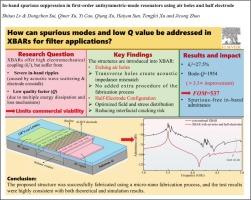In-band spurious suppression in first-order antisymmetric-mode resonators using air holes and half electrode
IF 5.4
2区 工程技术
Q1 ENGINEERING, MULTIDISCIPLINARY
Engineering Science and Technology-An International Journal-Jestech
Pub Date : 2025-10-14
DOI:10.1016/j.jestch.2025.102207
引用次数: 0
Abstract
Laterally excited bulk acoustic resonator (XBAR) exhibits a high electromechanical coupling coefficient (kt2) due to their intrinsically superior piezoelectric properties, which is highly advantageous for the subsequent design and implementation of acoustic filters. However,it is not yet suitable for commercial application due to its numerous spurious modes and low quality factor (Q value). This paper presents an exhaustive analysis of the origins of in-band spurious modes and the method to suppress based on the first-order antisymmetric (A1) mode XBAR. Simulation results indicate that these spurious modes primarily originate from acoustic wave scattering along unintended propagation paths and standing waves caused by crosstalk between electrodes. These spurious modes lead to energy dissipation, thereby reducing the resonator’s Q value. To effectively suppress them without increasing fabrication complexity while significantly enhancing the Q value, an etching-hole strategy is proposed, introducing the transverse holes that create acoustic impedance mismatch based on velocity differences. Additionally, the adoption of a half electrode configuration optimizes the electric field and stress redistribution within the resonator, thereby effectively reducing interfacial losses at the electrode-piezoelectric layer interface and enhancing the Q value by approximately 3.5 times. The fabricated XBAR, integrating holes and half electrode configuration, exhibits an in-band spurious-free response, a Bode-Q value of 1954, a kt2 of 27.5 % and an exceptionally high figure of merit (FOM = kt2 × Bode-Q) of 537.

利用空穴和半电极抑制一阶反对称模谐振器带内杂散
横向激发体声谐振器(XBAR)由于其固有的优异压电特性而具有较高的机电耦合系数(kt2),这对后续声滤波器的设计和实现非常有利。但由于其杂散模式多,质量因子(Q值)低,尚不适合商业应用。本文详细分析了带内杂散模的来源,并提出了一阶反对称(A1)模XBAR的抑制方法。仿真结果表明,这些杂散模式主要来源于非预期传播路径上的声波散射和电极间串扰引起的驻波。这些伪模导致能量耗散,从而降低了谐振器的Q值。为了在不增加制造复杂性的同时有效地抑制它们,同时显著提高Q值,提出了一种蚀刻孔策略,该策略引入了基于速度差产生声阻抗失配的横向孔。此外,采用半电极结构优化了谐振腔内的电场和应力分布,从而有效降低了电极-压电层界面处的界面损耗,使Q值提高了约3.5倍。所制备的XBAR集成了孔和半电极结构,具有带内无杂散响应,波德q值为1954,kt2为27.5%,优异值(FOM = kt2 ×波德q)为537。
本文章由计算机程序翻译,如有差异,请以英文原文为准。
求助全文
约1分钟内获得全文
求助全文
来源期刊

Engineering Science and Technology-An International Journal-Jestech
Materials Science-Electronic, Optical and Magnetic Materials
CiteScore
11.20
自引率
3.50%
发文量
153
审稿时长
22 days
期刊介绍:
Engineering Science and Technology, an International Journal (JESTECH) (formerly Technology), a peer-reviewed quarterly engineering journal, publishes both theoretical and experimental high quality papers of permanent interest, not previously published in journals, in the field of engineering and applied science which aims to promote the theory and practice of technology and engineering. In addition to peer-reviewed original research papers, the Editorial Board welcomes original research reports, state-of-the-art reviews and communications in the broadly defined field of engineering science and technology.
The scope of JESTECH includes a wide spectrum of subjects including:
-Electrical/Electronics and Computer Engineering (Biomedical Engineering and Instrumentation; Coding, Cryptography, and Information Protection; Communications, Networks, Mobile Computing and Distributed Systems; Compilers and Operating Systems; Computer Architecture, Parallel Processing, and Dependability; Computer Vision and Robotics; Control Theory; Electromagnetic Waves, Microwave Techniques and Antennas; Embedded Systems; Integrated Circuits, VLSI Design, Testing, and CAD; Microelectromechanical Systems; Microelectronics, and Electronic Devices and Circuits; Power, Energy and Energy Conversion Systems; Signal, Image, and Speech Processing)
-Mechanical and Civil Engineering (Automotive Technologies; Biomechanics; Construction Materials; Design and Manufacturing; Dynamics and Control; Energy Generation, Utilization, Conversion, and Storage; Fluid Mechanics and Hydraulics; Heat and Mass Transfer; Micro-Nano Sciences; Renewable and Sustainable Energy Technologies; Robotics and Mechatronics; Solid Mechanics and Structure; Thermal Sciences)
-Metallurgical and Materials Engineering (Advanced Materials Science; Biomaterials; Ceramic and Inorgnanic Materials; Electronic-Magnetic Materials; Energy and Environment; Materials Characterizastion; Metallurgy; Polymers and Nanocomposites)
 求助内容:
求助内容: 应助结果提醒方式:
应助结果提醒方式:


